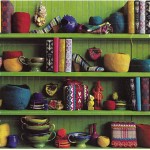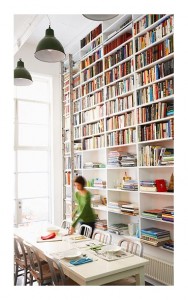Books, the idea: Suggesting wealths of learnedness
Posted Under: Things/Thinking
 A couple of weeks ago now I mentioned Nicholson Baker’s piece, “Books as Furniture,” from the June 12, 1995 New Yorker. (Thx again Jim Rosenau.) Like much of Baker’s best work, it’s based on simply noticing something that seems curious — and going to fantastic lengths to explain what that something is all about.
A couple of weeks ago now I mentioned Nicholson Baker’s piece, “Books as Furniture,” from the June 12, 1995 New Yorker. (Thx again Jim Rosenau.) Like much of Baker’s best work, it’s based on simply noticing something that seems curious — and going to fantastic lengths to explain what that something is all about.
In this instance, what he noticed was how frequently mail-order catalogs for furniture and clothing other lifestyle-product companies featured, as casual props in their carefully staged photographs, books. Along the way he makes several observations that, in addition to being quite relevant to this site’s occasional series on the idea of the book, are also just flat-out wonderful.
Poring over catalogs from The Company Store, Crate & Barrell, Crabtree & Evelyn, Tweeds, J. Crew, etc., Baker spotted book after book. Though their titles were often illegible, and many seemed chosen more for the color of the spine than whatever was on their pages, it was nonetheless the case that these images were
surrounding printed fiction with life-size fictional rooms that resemble our own real rooms except that they are a good deal neater, costlier, and more literate….
There isn’t a self-help book or current best-seller to be seen, because the men and women who live in the rooms of the mail-order catalogues never read best sellers. In fact, they never read paperbacks.
This leads into a highly useful history of book display, going back to the first century, “when some books were still published – that is, multiply copied – on rolls (volumina), and stored on their sides” in armoire-like cabinets that were the precursors to the bookcase, “with little tags hanging from their ends which bore their titles.” A Pottery Barn catalog perused by Baker alludes to this history in the blurb for an armoire. “But can its copywriter truly believe that anyone is now going to keep a book collection behind the closed pine doors of a nine-hundred-and-ninety-nine-dollar cupboard?” He answers: No.
Catalog designers know perfectly well that books, if we are fortunate enough to own any, should be out there somewhere, visible, shelved in motley ranks or heaped on tables as nodes of compacted linearity that arrest the casual eye and suggest wealths of patriarchal, or matriarchal, learnedess.
Unlike other collectibles, books “represent a different order of plenitude,” Baker writes, one that encompasses “the camel caravans of thought-bearing time to read them through.” And he quotes William Gladstone arguing against a fashion for ornamental bookcases; those objects should remain plain, Gladstone says, because books “are themselves the ornament.”
Is the fate of this ornament at long last threatened? That’s been an undercurrent of this series, I suppose. Or maybe it’s more accurate to say that I think this series has been suggesting that the ornament will survive, but will also evolve. Whether books have a future or not, I think the idea of the book does.
More on this tomorrow.




 "
"













 Kim Fellner's book
Kim Fellner's book  A
A
Reader Comments
Oh, those “…camel caravans of thought-bearing time…” and books themselves as the ornament!
More always to think about. Thanks for your piece, nicely done. Looking forward to tomorrow.